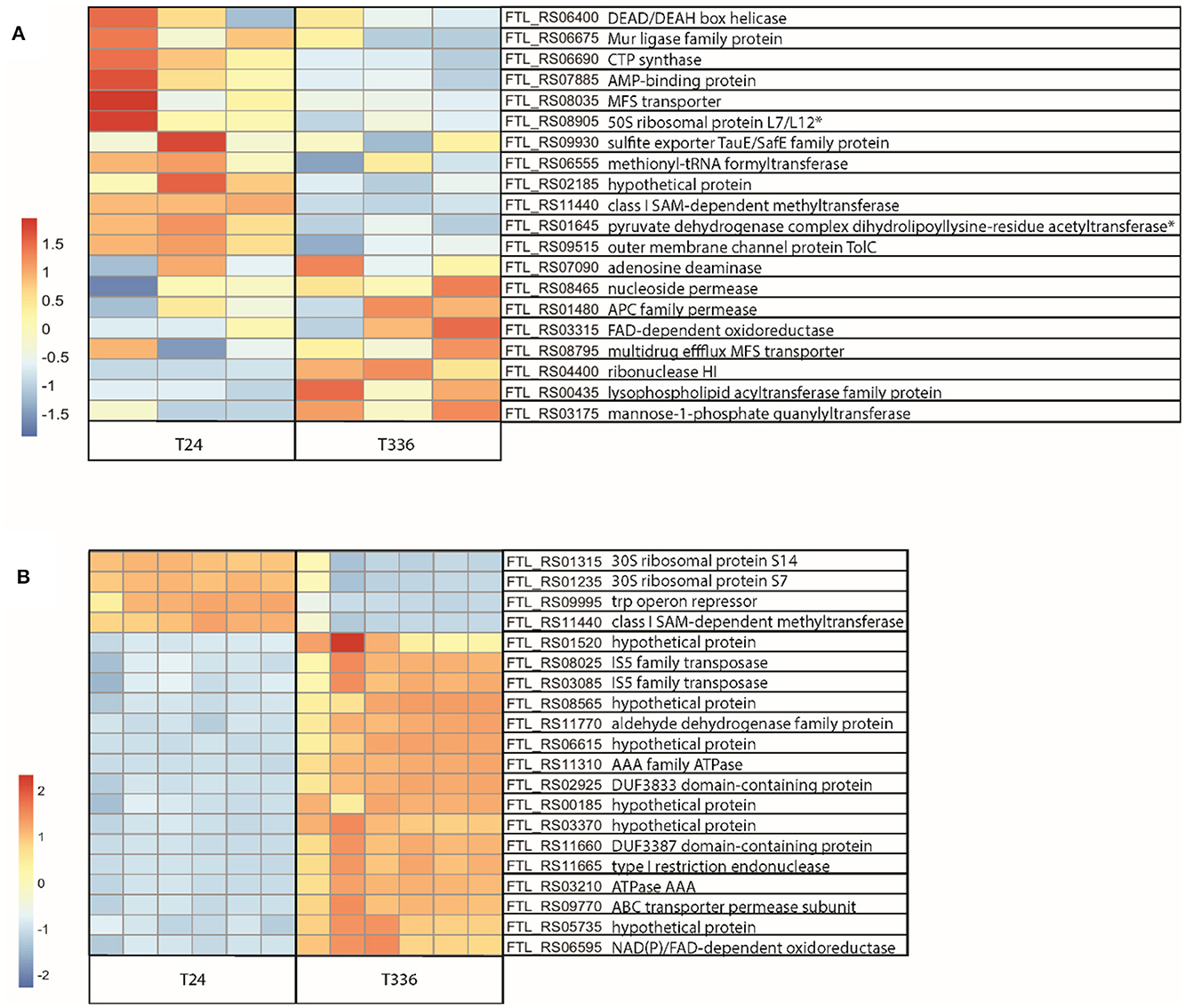Phenotypic and transcriptional characterization of F. tularensis LVS during transition into a viable but non-culturable state
- 1Department of Biomedical Sciences, West Liberty University, West Liberty, WV, United States
- 2Department of Biomedical Sciences, Joan C. Edwards School of Medicine, Marshall University, Huntington, WV, United States
- 3Department of Cell Biology, Center for Biologic Imaging, University of Pittsburgh, Pittsburgh, PA, United States
A corrigendum on
Phenotypic and transcriptional characterization of F. tularensis LVS during transition into a viable but non-culturable state
by Cantlay, S., Garrison, N. L., Patterson, R., Wagner, K., Kirk, Z., Fan, J., Primerano, D. A., Sullivan, M. L. G., Franks, J. M., Stolz, D. B., and Horzempa, J. (2024). Front. Microbiol. 15:1347488. doi: 10.3389/fmicb.2024.1347488
In the published article, there was an error in the legend for Figure 6 as published. The change in the Figure legend pertains to Figure 6A. The DEGs were identified by normalized count differences and, whilst all but two were also statistically significantly different, the wording has been changed to make it clear that normalized counts were used to identify and rank the genes for the nanopore experiment and the non-significant DEGs are indicated. Also, there was an error in Figure 6 as published. The protein product names in Figure 6 did not match the FTL_RS identifiers due to a sorting error when the names were added in the figure editing process (Excel->Adobe Illustrator). These protein names were manually added using a list of genes for each analysis (nanopore and illumina) that were sorted differently from the clustered order the heatmap figure generated. We have verified that the FTL IDs associated with the heatmaps are accurate in the corrected Figure 6. The protein names have been sorted properly and added to the fixed version of Figure 6. The corrected Figure 6 and its caption appear below.

Figure 6. RNA-Seq analysis of Francisella tularensis LVS during transition to the VBNC state. F. tularensis was cultured in Chamberlain's Defined Medium (CDM) for 24 and 336 h and RNA isolated from three biological replicates (Nanopore) or six biological replicates (Illumina) was sequenced. (A) Top 20 DEG normalized count differences between the T24 and T336 Nanopore experiment samples; associated FTL identifiers and products in table, non-significant DEGs indicated with *. (B) Differences in the top 20 most significant DEGs between the T24 and T336 Illumina experiment samples; associated FTL identifiers and products in table.
The authors apologize for this error and state that this does not change the scientific conclusions of the article in any way. The original article has been updated.
Publisher's note
All claims expressed in this article are solely those of the authors and do not necessarily represent those of their affiliated organizations, or those of the publisher, the editors and the reviewers. Any product that may be evaluated in this article, or claim that may be made by its manufacturer, is not guaranteed or endorsed by the publisher.
Keywords: Francisella tularensis, viable but non-culturable (VBNC), RNA-Seq, transcriptomics, bacterial physiology, host-microbe interaction
Citation: Cantlay S, Garrison NL, Patterson R, Wagner K, Kirk Z, Fan J, Primerano DA, Sullivan MLG, Franks JM, Stolz DB and Horzempa J (2024) Corrigendum: Phenotypic and transcriptional characterization of F. tularensis LVS during transition into a viable but non-culturable state. Front. Microbiol. 15:1407526. doi: 10.3389/fmicb.2024.1407526
Received: 26 March 2024; Accepted: 08 April 2024;
Published: 22 April 2024.
Edited and reviewed by: Max Maurin, Centre Hospitalier Universitaire de Grenoble, France
Copyright © 2024 Cantlay, Garrison, Patterson, Wagner, Kirk, Fan, Primerano, Sullivan, Franks, Stolz and Horzempa. This is an open-access article distributed under the terms of the Creative Commons Attribution License (CC BY). The use, distribution or reproduction in other forums is permitted, provided the original author(s) and the copyright owner(s) are credited and that the original publication in this journal is cited, in accordance with accepted academic practice. No use, distribution or reproduction is permitted which does not comply with these terms.
*Correspondence: Stuart Cantlay, stuart.cantlay@westliberty.edu
 Stuart Cantlay
Stuart Cantlay Nicole L. Garrison
Nicole L. Garrison Rachelle Patterson1
Rachelle Patterson1 Donald A. Primerano
Donald A. Primerano Mara L. G. Sullivan
Mara L. G. Sullivan Jonathan M. Franks
Jonathan M. Franks Joseph Horzempa
Joseph Horzempa